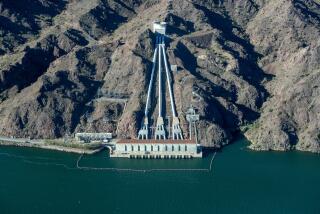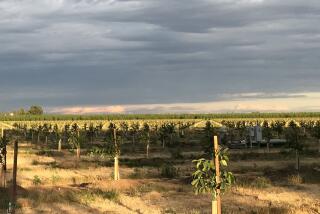Farm, Town Alike Beset by Montana Drought
- Share via
RYEGATE, Mont. — Wiley Micks worries whether he’ll have enough water to irrigate his summer hay crops. He fears too that if he can’t grow his own, finding hay for his cattle at a price he can afford will be just as tough.
“The neighbors, everybody keeps talking about what it’s going to take to heal us up,” said Micks, a ranch manager north of Ryegate in south-central Montana. “But you can’t control it.”
Faced with another dry year, farmers and ranchers who rely on irrigation to survive are concerned about the availability of water.
In recent months, stock ponds and historic springs have dried up. Some ranchers have sold cattle because of poor--or no--pastures.
They’re not alone. Cities that rely on surface water are preparing for limited supplies and use restrictions, and problems also have started seeping up in communities with shallow ground water sources.
The Rocky Mountain snowpack, the chief source of water for Montana’s rivers and streams, is far below average in Montana, according to a report by the Natural Resources Conservation Service that measured levels as of April 1.
Seven of Montana’s 26 river basins had record low water content, and the snowpack statewide was 58% of average. Forecasts for very low stream flows through July heightened concerns of possible shortages. April rain and snow have helped the situation some but fell far short of remedying the shortage, officials said.
All Montana counties have been declared drought areas by the state, and county commissioners have been asked to prepare plans. A Climate Prediction Center forecast shows drought conditions likely to persist in most of Montana.
“It’s nice to have the mild winters--but we pay for it later,” said Theo Yanzick, who ranches with her husband, Bruce, near Absarokee in south-central Montana and draws water from the Stillwater River to irrigate alfalfa crops.
Farmers are not the only ones anxiously looking toward summer.
“We’re quite concerned about the weather here,” said Steve Ruhd, public works director for Conrad, a small north-central Montana city that depends on Lake Francis for its water supply, along with local farmers and ranchers. Residents couldn’t water their lawns last summer and probably wouldn’t be able to this year, he said.
“We are expecting, as far as we’re concerned, to be really limited on the amount of water we receive,” Ruhd said.
Water rights are formal legal rights in the West. Most farmers and ranchers who rely on streams and rivers for irrigation get it on a “first in time, first in right” principle, with those holding the oldest water rights getting first dibs. Conrad, with nearly 1,300 water accounts, also holds water rights, but it must get in line with farmers and ranchers; the needs of townspeople don’t take precedence.
“I think we have an understanding that residents can’t go without water. Health and safety should come before irrigation,” Ruhd said. “But that’s more of an understanding than anything legal.”
Water commissioners appointed by state judges can require junior water-rights holders to stop drawing water in a dry year so those with more senior rights have sufficient water, said Keith Kerbel, the state’s regional manager for water resources in Billings.
Last year in Carbon County, irrigators with water rights dating back to 1894 had their water allotment reduced, said Ray McPhail, district conservationist with the Natural Resources Conservation Service in Joliet. Their rights weren’t cut, but water levels were so low that what little was left had to be divided among the oldest rights holders, many of whom got less than expected.
The situation looks no better this year.
The U.S. Drought Monitor, which tracks and reports conditions for several federal agencies, said in early April that severe drought gripped more than half the state, with moderate drought and abnormally dry conditions in the east and only a narrow band along the North Dakota border unaffected.
“Drought is something farmers can’t do a lot about, and it frustrates people to no end to see the results of their hard work unravel,” said Jess Aber, a state water resources planner in Helena. “It’s a grim picture.”
*
On the Net:
U.S. Drought Monitor: https://https://enso.unl.edu/monitor/monitor.html
Montana Drought Monitoring 2001: https://https://nris.state.mt.us/drought/
More to Read
Sign up for Essential California
The most important California stories and recommendations in your inbox every morning.
You may occasionally receive promotional content from the Los Angeles Times.













